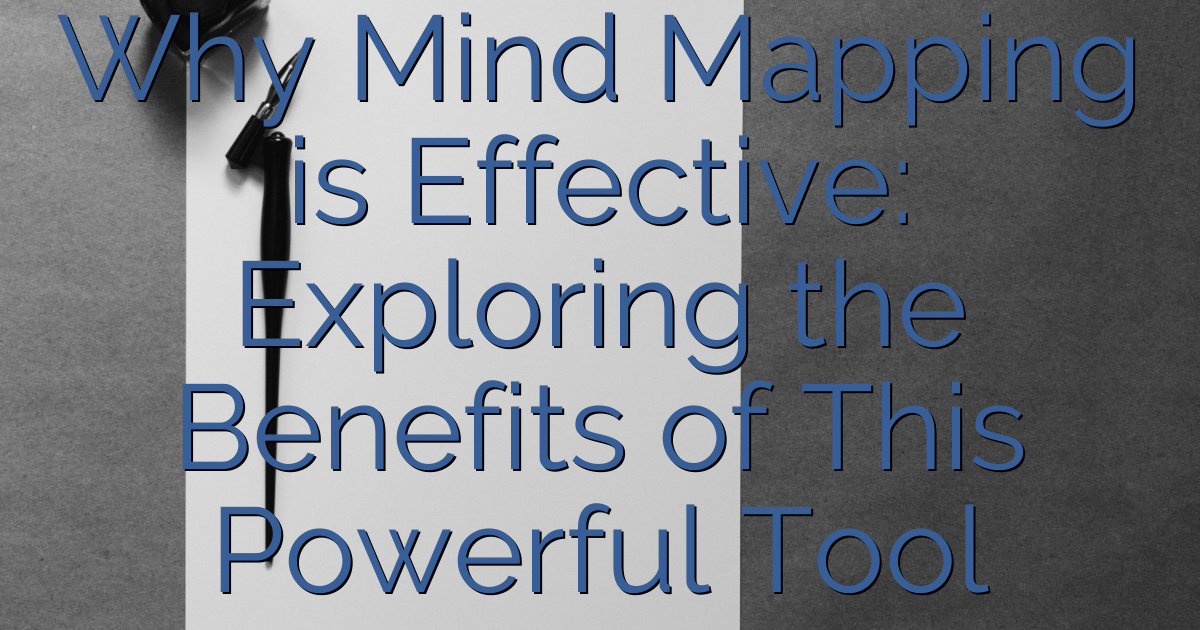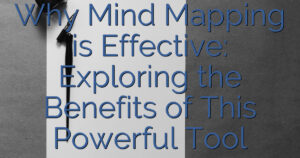
Mind mapping is a powerful tool that has become increasingly popular in recent years. It is a visual method of organizing and presenting information that allows individuals to better understand and remember complex ideas. Mind maps can be used for a variety of purposes, from brainstorming and problem-solving to note-taking and studying.
Understanding mind mapping is essential to understanding why it is so effective. Mind maps are graphical representations of information that use keywords and images to create a visual map of ideas. This approach to information organization is based on the way the brain naturally processes and stores information, making it a highly effective tool for learning and memory retention.
The effectiveness of mind mapping can be attributed to several factors. First, mind maps allow individuals to see the big picture and the relationships between different ideas, making it easier to understand complex concepts. Second, mind maps engage both the left and right hemispheres of the brain, making it easier to remember information. Finally, mind maps are highly customizable, allowing individuals to tailor them to their specific needs and learning styles.
Table of Contents
Key Takeaways – Why Mind Mapping is Effective
- Mind mapping is a visual method of organizing and presenting information that allows individuals to better understand and remember complex ideas.
- Mind maps use keywords and images to create a visual map of ideas, based on the way the brain naturally processes and stores information.
- Mind mapping is effective because it allows individuals to see the big picture, engages both hemispheres of the brain, and is highly customizable.
Understanding Mind Mapping
Mind mapping is a visual technique that helps individuals organize and structure their thoughts, ideas, and information. It involves creating a diagram that starts with a central idea or topic and branches out into subtopics and related ideas.
The main advantage of mind mapping is that it mimics the way the brain works. It allows individuals to think associatively, which means that they can link ideas together based on similarities, differences, or relationships. This type of thinking is more natural and effective than linear thinking, which involves organizing information in a sequential or chronological order.
To create a mind map, individuals start with a central idea or keyword and then add branches that represent related ideas or subtopics. Each branch can then be further expanded with additional branches and keywords. Mind maps can be created on paper or using software tools that provide more flexibility and customization options.
One of the key benefits of mind mapping is that it helps individuals to see the big picture and the details at the same time. It provides a visual overview of the information, which makes it easier to understand and remember. In addition, mind maps can be used for a variety of purposes, such as brainstorming, note-taking, planning, problem-solving, and decision-making.
Overall, mind mapping is an effective tool for organizing and structuring information. It helps individuals to think more creatively, efficiently, and systematically. By using mind maps, individuals can improve their productivity, memory, and comprehension.
Effectiveness of Mind Mapping
Mind mapping is an effective tool that helps individuals to organize their thoughts and ideas. It is a visual technique that allows people to connect concepts and ideas in a non-linear way. Here are some of the ways in which mind mapping is effective:
Promotes Active Learning
Mind mapping is an active process that engages the learner in the process of creating and organizing information. It is a visual and kinesthetic learning technique that encourages learners to actively participate in the learning process. This technique allows learners to organize their thoughts and ideas in a way that makes sense to them, which promotes deeper understanding and retention of the material.
Enhances Memory and Recall
Mind mapping is an effective tool for enhancing memory and recall. According to a study conducted by the University of Waterloo, mind maps help individuals to remember information better than traditional note-taking methods. The study found that individuals who used mind maps to take notes were able to recall significantly more information than those who used traditional note-taking methods.
Facilitates Creativity
Mind mapping is a creative process that allows individuals to generate new ideas and connections between concepts. It is a non-linear technique that encourages individuals to think outside the box and make connections that they may not have otherwise made. This technique allows individuals to explore new ideas and concepts in a way that is not limited by traditional linear thinking.
In conclusion, mind mapping is an effective tool that promotes active learning, enhances memory and recall, and facilitates creativity. It is a visual and kinesthetic learning technique that engages learners in the learning process and allows them to organize their thoughts and ideas in a way that makes sense to them.
Practical Applications of Mind Mapping
Mind mapping is a versatile tool that can be used in a variety of settings, from academia to the workplace to personal projects. Here are some practical applications of mind mapping:
Academic Use
Mind mapping can be particularly helpful for students who need to organize and connect information for studying, writing papers, and preparing presentations. Students can use mind maps to:
- Brainstorm ideas for essays or projects
- Organize notes from lectures and readings
- Create outlines for papers and presentations
- Connect related concepts and ideas for better understanding
Professional Use
Mind mapping can also be useful in the workplace for project management, brainstorming, and problem-solving. Professionals can use mind maps to:
- Plan and manage projects
- Brainstorm ideas for new products or initiatives
- Organize and prioritize tasks and goals
- Visualize complex data and information
- Collaborate with team members on projects
Personal Use
Mind mapping can also be a valuable tool for personal projects and goals. Individuals can use mind maps to:
- Plan and organize personal projects, such as home renovations or travel itineraries
- Set and track personal goals, such as fitness or career goals
- Brainstorm ideas for creative projects, such as writing or art
- Visualize and prioritize tasks and to-do lists
Overall, mind mapping is a useful technique for organizing and connecting ideas, data, and information. With its versatility and flexibility, mind mapping can be a valuable tool in a variety of settings and for a range of purposes.
Process of Mind Mapping
Mind mapping is a powerful tool that helps you to organize your thoughts, ideas, and information in a structured and visual way. The process of mind mapping involves three key steps: selecting a central idea, identifying key themes, and adding details.
Selecting a Central Idea
The first step in mind mapping is to select a central idea. This idea should be the main focus of your mind map and should be placed in the center of the map. The central idea can be a word, phrase, or image that represents the topic you want to explore.
Identifying Key Themes
Once you have selected a central idea, the next step is to identify key themes related to that idea. These themes should be placed around the central idea and connected to it with lines. Key themes can be represented by words, images, or symbols that capture the essence of the theme.
Adding Details
The final step in mind mapping is to add details to each theme. These details can be ideas, facts, or examples that support the theme. Details should be placed on branches that extend from each theme and connected to the theme with lines.
Mind mapping is a flexible and dynamic process that allows you to add, remove, and rearrange elements of the map as needed. The process of mind mapping can be done on paper or using software tools, depending on your preference.
Overall, the process of mind mapping is an effective way to organize your thoughts, generate new ideas, and communicate complex information. By following these three key steps, you can create a clear and visually appealing mind map that helps you to better understand and communicate your ideas.
Common Misconceptions About Mind Mapping
There are several misconceptions about mind mapping that can prevent people from using this effective technique. Here are some common ones:
Misconception #1: Mind Mapping is Only for Creatives
One of the biggest misconceptions about mind mapping is that it is only useful for creative people. While it is true that artists, writers, and designers use mind mapping to generate ideas and organize their thoughts, anyone can benefit from this technique. Mind mapping can be used in various settings, including business, education, and personal life.
Misconception #2: Mind Mapping is Time-Consuming
Another misconception about mind mapping is that it takes a lot of time to create a mind map. However, this is not true. Mind maps are meant to be quick and easy to create. In fact, a mind map can be created in minutes, and it can save you time in the long run by helping you organize your thoughts and ideas.
Misconception #3: Mind Mapping is Only for Large Projects
Some people believe that mind mapping is only useful for large and complex projects. However, mind mapping can be used for any project, big or small. It is a versatile tool that can help you organize your thoughts, plan your day, or even create a grocery list.
Misconception #4: Mind Mapping is Just Fancy Note-Taking
Finally, some people think that mind mapping is just a fancy way of taking notes. However, mind mapping is much more than that. It is a visual tool that helps you see the big picture, make connections between ideas, and generate new insights. Mind mapping can help you think more creatively, solve problems more effectively, and communicate more clearly.
Overall, these misconceptions can prevent people from using mind mapping to their advantage. By understanding the true benefits of mind mapping, anyone can use this technique to improve their productivity, creativity, and problem-solving skills.
Overcoming Obstacles in Mind Mapping
While mind mapping can be a powerful tool for organizing thoughts and generating ideas, there are some common obstacles that people may encounter. Here are some tips for overcoming these obstacles:
1. Overthinking
One of the biggest obstacles to effective mind mapping is overthinking. When people get too caught up in trying to create the perfect mind map, they can end up wasting time and losing focus. To overcome this obstacle, it can be helpful to remember that mind mapping is meant to be a quick and fluid process. Don’t worry about making the perfect map – just focus on getting your ideas down on paper.
2. Lack of Focus
Another obstacle to effective mind mapping is a lack of focus. When people try to map out too many ideas at once, they can end up with a cluttered and confusing map. To overcome this obstacle, it can be helpful to break down your ideas into smaller, more manageable chunks. Start with a main idea or goal, and then add sub-ideas or action steps as needed.
3. Limited Imagination
Sometimes people may struggle with mind mapping because they feel like they don’t have a very creative imagination. To overcome this obstacle, it can be helpful to try using different types of mind maps, such as color-coded maps or image-based maps. You can also try brainstorming with a group of people to get more ideas and inspiration.
4. Lack of Structure
Finally, some people may struggle with mind mapping because they feel like there is no clear structure or organization to their map. To overcome this obstacle, it can be helpful to use different types of symbols or formatting to indicate different types of ideas or categories. You can also try using different colors or fonts to create a more visually appealing map.
Overall, while there may be some obstacles to effective mind mapping, with a little practice and experimentation, anyone can learn to create effective and useful mind maps.
